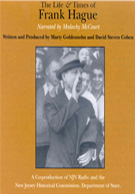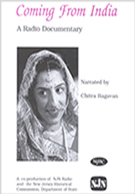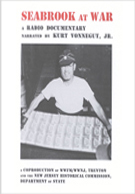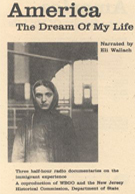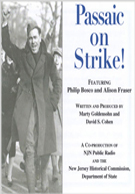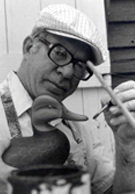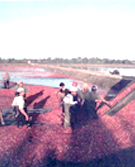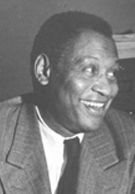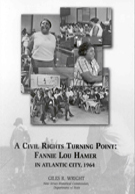

A co-production of NJN Public Television and the New Jersey Historical Commission produced in the early 1990s. All videos are available online. The NJ Historical Commission continually works to update its website with new educational materials in New Jersey history.
(Intended for use in grades K through 4).
At the Howell Living History Farm in Mercer County, farming is done as it was at the turn of the twentieth century. The staff shows how sheep were sheared and demonstrates horsedrawn farm equipment.
At the Paterson Museum, Jack De Stefano demonstrates the operation of a power loom and describes the working conditions of women and children in the Paterson mills. At Castle and the Botto House, students see how the owners and the workers lived differently.
John Kraft conducts a tour of a reconstructed Lenape Indian village and demonstrates how the Lenape built houses, cultivated fields, raised children, cooked, hunted, and fished. He explains how the Lenape way of life changed when Europeans arrived.
At this African American reunion, stories are told about Charity Still and her sons, James, William and Peter. Charity ran away from slavery in Maryland to join her husband in New Jersey. James was a self-trained doctor, William worked on the Underground Railroad, and Peter purchased his own and his family's freedom.
Park Ranger Ben Bolger conducts a tour of Thomas Edison's West Orange research laboratories. Students learn how three of Edison's inventions; the electric light, the phonograph, and the motion picture camera changed the way we live, work, and play.
In the home of our state government, Karen Polling discusses the meaning of democracy and representative government. By visiting the General Assembly, the Senate Chambers, and the Governor's Outer Office, students learn how a bill becomes a law.
George Washington brought his army to Morristown twice during the Revolutionary War: first, in January 1777, after he crossed the Delaware and defeated the British at the battles of Trenton and Princeton, and again in December 1779. The winter of 1779-80 was one of the worst of the century, but Washington managed to quiet the complaints of the soldiers and hold the army together.
Roosevelt, N.J. was founded by the federal government during the Great Depression as a way to resettle in the countryside Jewish immigrant garment workers living in the slums of New York City. The program focuses on the mural in the Roosevelt Elementary School painted by the famous artist Ben Shahn, which links the history of the town to the history of Jewish immigration to America. Teacher Ilene Levine guides a fourth-grade class through oral history interviews with Bernarda Bryson Shahn, Ben Shahn's widow, and Augusta Chasan, one of the first settlers in the town. Art teacher Rita Williams has the students paint their own versions of the mural.
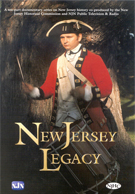
The goals of New Jersey Legacy are to reach a broad audience with high-quality television programs about New Jersey history. To place New Jersey history in the context of American and world history; to show how a knowledge of the past helps us understand the present; To incorporate women’s history, African–American history, ethnic history, and labor history into the study of New Jersey history. All videos are available online. The NJ Historical Commission continually works to update its website with new educational materials in New Jersey history.
A co-production of the NJN Public Television and the NJ Historical Commission (intended for use in middle and high schools)
For centuries, the Lenape Indians lived on the land that would become New Jersey. However, their way of life began to change in 1609 when Henry Hudson explored the Atlantic shoreline. Anticipating potential fortunes from the fur trade, the Dutch established the colony of New Netherland. They soon came into conflict with the Lenape, and then with the English and the Swedes, who also sought control of the region.
After the English conquest of New Netherland, King Charles II of Britain granted the former Dutch territories to his brother James, Duke of York, who divided the colony into New York and New Jersey. James gave New Jersey to his friends, John, Lord Berkeley, and Sir George Carteret, who sold their shares to other investors, known as proprietors. In 1676, the colony was divided into East and West Jersey. From the outset, the two New Jerseys were beset with problems. In 1702, the proprietors asked the crown to take over the government, reuniting New Jersey.
The reunion of East and West Jersey did not solve New Jersey's problem. New Jersey still shared a governor with New York, and the governor aroused the ire of many New Jerseyans. Additionally, land ownership continued to be disputed, resulting in widespread rioting. At the same time, a religious revival, known as the Great Awakening, spread throughout the British colonies, resulting in the founding of Rutgers and Princeton universities. In challenging established church authorities, the revival helped pave the road to the American Revolution.
New Jersey was the Crossroads of the American Revolution, being strategically located between the British military headquarters in New York City and the Continental Congress sitting in Philadelphia. New Jersey's role in the American Revolution begins with the protests against the Stamp Act and other British imperial measures, includes the passage of New Jersey's first state constitution of 1775, and Washington's stunning victories over the British in the battles of Trenton and Princeton, and concludes with the effects of the Revolution on women and blacks.
Alexander Hamilton's vision of a manufacturing center at the Falls of the Passaic River lays the groundwork for the founding of the Society for Establishing Useful Manufactures in Paterson in 1791. To encourage internal improvements New Jersey chartered corporations and the granted of transportation monopolies to steamboat and railroad companies. The so-called Market Revolution resulted in a fissure in the unified world of masters, journeymen and apprentices of the colonial period. It changed home-life as well as work-life, resulting in a new definition of women's roles.
The American Revolution unleashed a flurry of new ideas about freedom and equality. But not everyone in the early nineteenth century enjoyed these rights. While women and free blacks who owned property could vote under New Jersey's 1776 constitution, that right was taken away from them in 1807. African Americans and Quakers helped slaves from the South escape through New Jersey on the Underground Railroad. After the Civil War, the women's movement split over the Fourteenth and Fifteenth Amendments to the U. S. Constitution, which guaranteed the right to vote to African American men, but not to women.
New Jersey had been ethnically and religiously diverse since colonial times. However, the colonial religious denominations were almost all Protestant. In the early nineteenth century immigration shifted to Germany and Ireland, and many of these newcomers were Catholics. Middle-class reformers attempted to "Americanize" the German and Irish immigrants by promoting temperance and using the newly created public schools to make the immigrants into good Americans (meaning, Protestants). In response, the Germans and Irish created their own parochial schools and requested the state to provide funding.
In 1876, Thomas Alva Edison opened his so-called “invention factory” on a hill in Menlo Park overlooking the Pennsylvania Railroad tracks. Between 1876 and 1882 Edison filed more than 300 patents, including the phonograph, the motion picture camera, and the electric light. There were, however, social implications for technological development. When Paterson broad-silk manufacturer Henry Doherty increased the work assignments from two to four looms, his weavers went on strike with the support of the radical Industrial Workers of the World.
In the gubernatorial election of 1910 the Democratic Party nominated the president of Princeton University, Woodrow Wilson. As governor, Wilson proposed reforms, including direct primary elections, banning of ballot box stuffing, an authority to regulate public utilities, and a workmen's compensation act. The period also witnessed a Great Migration of African Americans from the South to industrial northern cities like Newark and a successful campaign to gain the right to vote for women led by Alice Paul from Mt. Laurel.
The second half of the twentieth century witnessed a major shift in political power in New Jersey from a coalition of rural Republicans and urban Democrats to the suburbs. The new state constitution of 1947 established a powerful Supreme Court, which became a flashpoint on the issues of school funding and discriminatory zoning.
The series was co-produced by the New Jersey Historical Commission and NJN Public Television.
